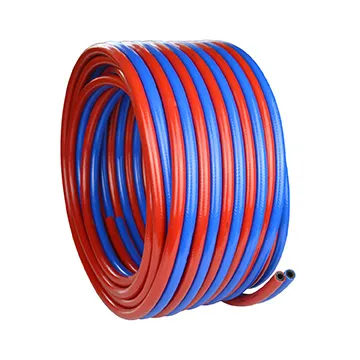twin welding hose
Understanding Twin Welding Hoses A Comprehensive Guide
Welding is a critical process in various industries, from construction to automotive. Whether it's for fabricating metals, repairing machinery, or crafting artistic metalwork, the equipment used in welding is essential for achieving high-quality results. Among the many tools and materials employed in welding, twin welding hoses play a pivotal role. This article will delve into what twin welding hoses are, their features, applications, and the benefits they offer.
What Are Twin Welding Hoses?
Twin welding hoses are specialized tubes designed for the safe and efficient transport of gases used in welding processes, primarily oxygen and acetylene. These hoses are constructed as two parallel tubes, typically connected by an outer layer of protective material. The key characteristic of twin welding hoses is that they allow for both oxygen and acetylene to be carried simultaneously, which is especially useful for oxy-fuel welding and cutting applications.
Features of Twin Welding Hoses
1. Durability Twin welding hoses are made from high-quality rubber or thermoplastic materials that provide excellent resistance to abrasion, heat, and chemicals. This durability ensures that they can withstand the rigors of tough working environments.
2. Color-Coding Typically, the hoses are color-coded for safety—usually green for oxygen and red for acetylene. This color differentiation helps prevent hazardous mixing of gases and enhances user safety.
4. Pressure Ratings These hoses come with specific pressure ratings, which are crucial for maintaining safe operating conditions. Choosing hoses that suit the application’s pressure requirements is essential to avoid accidents.
twin welding hose

Applications of Twin Welding Hoses
Twin welding hoses are used in various applications, predominantly in industries involving fabrication and repair. Common uses include
- Metal Fabrication In workshops, twin hoses facilitate the joining of metal pieces from intricate artistic designs to large structural components. - Automotive Repair Mechanics employ oxy-fuel welding for repairing various parts of vehicles, ensuring that fittings are seamless and strong. - Plumbing Professionals use these hoses to connect pipes securely and efficiently, especially for soldering tasks.
Benefits of Using Twin Welding Hoses
1. Efficiency Having both gases available in a single, combined hose reduces setup time and enhances workflow efficiency. Welders can easily access both gases without needing to switch hoses.
2. Safety The design of twin welding hoses minimizes the risk of leaks and gas contamination, thus contributing significantly to workplace safety. Their color-coded nature further mitigates the chances of error.
3. Cost-Effective Using a twin hose system can be more economical compared to purchasing and managing separate hoses. This setup reduces the need for additional storage and maintenance.
Conclusion
In conclusion, twin welding hoses are essential tools in the welding industry, offering durability, flexibility, and safety in gas transport. Their applications across various fields highlight their versatility and importance in achieving high-quality welding results. By understanding the features and advantages of twin welding hoses, welders and industry professionals can enhance their work efficiency and ensure safer operations. As technology advances, we can expect continued innovations in welding equipment, solidifying the role of twin welding hoses as a staple in the welding process.
-
Unrivaled Performance and Applications of PU Pneumatic Hoses and TubesNewsJun.11,2025
-
The Transparent World of Industrial Tubing and Hosing SolutionsNewsJun.11,2025
-
The Intricate World of Pneumatic Conduits: Tubes and HosesNewsJun.11,2025
-
The Dynamic Landscape of Pneumatic Conduits: Unraveling Key ComponentsNewsJun.11,2025
-
The Diverse Applications and Significance of Transparent PVC TubingNewsJun.11,2025
-
High - Pressure Pneumatic Tubing and Systems: An In - Depth LookNewsJun.11,2025














